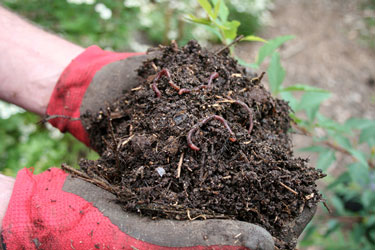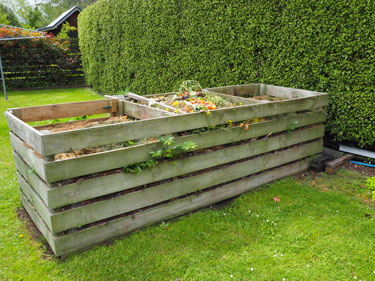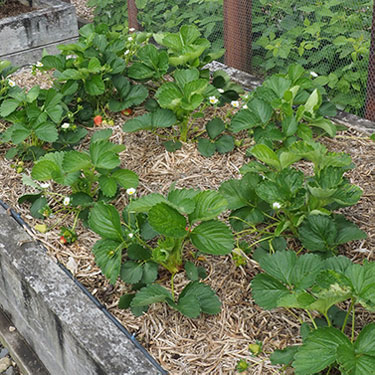Soil builders
Beneath the garden lies a world of its own - a highly complex network of mineral particles (clay, silt and sand), air and water - and life! Living organisms comprise a tiny percentage of a soil’s volume, but there are more of them in a handful of healthy topsoil than there are people living on earth. We ignore them at our peril.
Our soil is home not only for the worms we can see, but billions of bacteria, fungi and other microscopic green life beings all working together, binding
soil particles and making water and nutrients accessible to our plants as they transform organic matter into humus, the black stuff that gives topsoil its healthy dark colour.
Great soil is a highly prized resource worth looking after. And if your soil is less than great, there is much that can be done to improve it over time. Here are five cost-effective and time-saving ways to improve your soil:
1. Make compost
Buying good quality compost, in bags or by the trailer load, is a wise investment, but you can make your own for free. Devising a workable composting system that fits your lifestyle is a fantastic way to reduce food waste while building better soil, and if you make your own, you have the benefit of knowing exactly what goes into it. Composting options include hot composting, cold composting, fermentation and worm farming. Many gardeners combine more than one system.
Hot composting requires the building, all in one go, of a large heap (at least a square metre) using a balance of ‘green' (high in nitrogen) and ‘brown’ (high in carbon) ingredients. This results in microbial activity that releases heat. When the middle of the heap reaches peak heat it is turned to ‘stoke the fire’ with oxygen and feed the microbes. The results are fast and effective. Cold composting takes longer but is more convenient.
Like hot composting, it uses a balance of ‘green’ and ‘brown’ ingredients . The heap is built up gradually as kitchen waste is added. Turning is optional. Fermentation or ‘Bokashi’ composting relies on special anaerobic bacteria, which are available in garden centres. This is composting without air in a closed bucket with a lid. Effectively ‘pickled’, the raw material doesn’t change much in appearance, but decomposes very quickly once buried in the soil. One advantage of this system is that all food scraps can be managed, even meat. If there is no backyard for burying, the finished product can be dropped off at a community garden or other grateful recipient.
A worm farm is a worthwhile addition to any composting system, producing a ready supply of liquid fertiliser as well as worm castings, a valuable source of nutrients and soil humus.
HINT: The smaller the pieces of raw material, the greater the surface area for worms and other soil organisms to work on, so the faster the raw material will be converted into compost.
2. Keep the soil covered
Leaving the soil exposed to the ravages of rain, wind, and sun is a fast way to ruin its precious qualities, depleting the life within it. The best soil covers are plants. Otherwise, we can mimic nature’s forest floor to keep bare soil protected with a layer of organic mulch.
Wood chip is an attractive option that simulates the same natural process occurring in nature. Fallen leaves collected and stored in bags to break down over winter or added to the compost heap are full of minerals and a wonderful source of carbon. Using a mower with catcher attached is an easy way to gather the leaves while cutting them up for faster decomposition.
Straw is a perfect mulch for vegetable gardens as it is safe and easy to use around soft young plants. One bale of pea straw covers a lot of soil. It can be used in conjunction with layers of newspaper to keep weeds and moisture in.
3. Dig less
Digging is a gardening tradition and it’s not always avoidable, but for the sake of the soil (and our backs) the less we dig, the better. Every time we dig we are destroying micro-organisms while releasing carbon into the atmosphere. Turning the soil over with a deep digging spade also brings weed seeds to the surface. Try a digging fork instead to more gently aerate and loosen the soil without digging it over.
There is a trend world-wide towards ‘no till’ food production to reduce soil degradation and protect the environment. One way to prepare new areas for planting without digging is to use a tarp, old carpet or cardboard to block the light, thus killing the grass or weeds. Layers of cardboard or newspaper may be covered with organic mulch or compost for planting straight into.
4. Create beds and pathways
Walking on garden soil compacts it and harms soil life. The best way to avoid this is to organise the garden into permanent beds narrow enough for easy reach without standing on the soil.
Growing vegetables in raised beds also provides the perfect opportunity for a ‘no-dig’ garden. In its simplest form this is a thick layer of compost on top of bare soil with a layer of straw on top. Plant roots thrive in the compost layer while the straw layer preserves moisture, eventually breaking down to become another layer of compost. Soil life is continuously replenished when compost and mulch are added with each new planting.
Setting up a raised bed and filling it with soil is more expensive than creating a vegetable garden at ground level but saves time and energy in the long run.
5. Grow your own manure
A ‘cover crop’ is a patch of quick growing annuals that’s sown over soil (usually in autumn) and then incorporated into the soil (usually in spring) before the next crop is planted. As well as protecting the soil surface from the weather, a cover crop feeds the soil with bulk nitrogen and other nutrients. It can help draw deeper soil minerals to the soil surface. Its deep reaching roots aerate the soil, reducing compaction and improving the movement of soil water and nutrients. Cover crops can also help break disease cycles. Popular cover crops include lupin, mustard, wheat, barley and oats. All provide different plant benefits and a mixture is often sown, enhancing biodiversity above the soil and below. Lupin converts nitrogen from the air into plant-available nitrogen via ‘nitrogen fixing’ bacteria in its roots. Mustard helps against problematic soil fungi.
The cover crop is cut down before it sets seed, and then allowed to break down for a few weeks before the new season’s food crops are planted. In a no-dig system, gardeners make holes or channels (aka furrows) for planting among the cover crop stubble, or use a fork to turn cover crops into the soil. Sheet mulching is another way to suppress a cover crop without digging.

15-Sep-2022

Worms are a sign of healthy soil and compost

Make compost, on a grand or smaller scale.

Use mulch to protect soil. Straw also keeps strawberries dry and helps reduce fruit rot.

Cover crops protect the soil from weathering, support microbes in the soil and return valuable nutrients when dug in.

